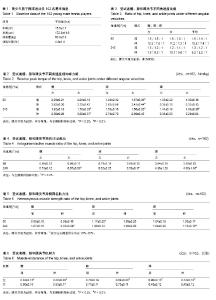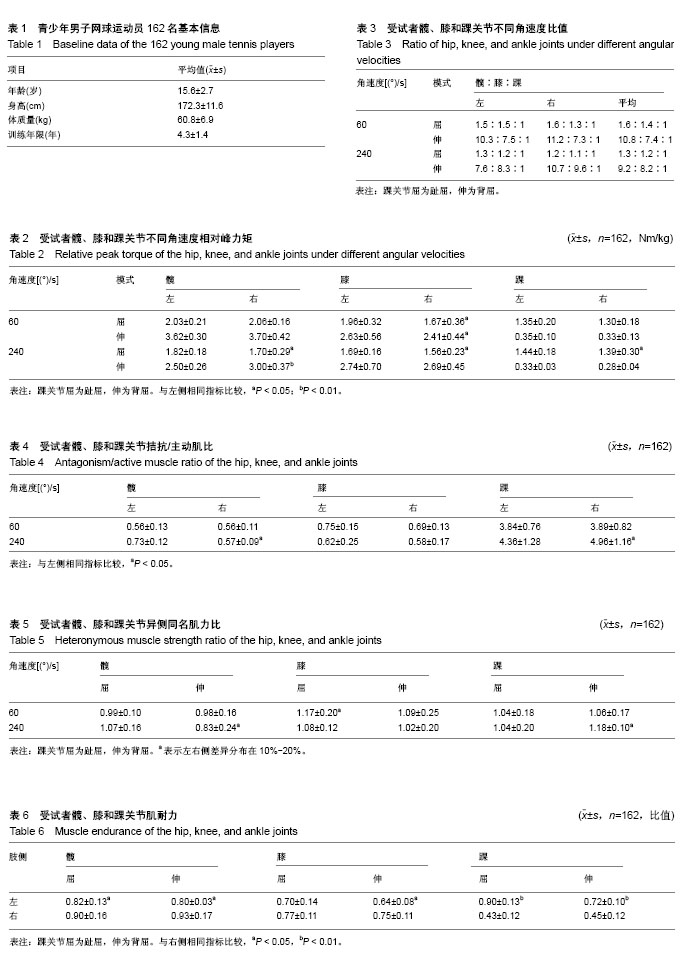| [1] 吴新华,蒋云飞,程亮,等.优秀男子跳远运动员下肢关节等速肌力特征的分析[J].成都体育学院学报, 2013, 39(10):86-89.[2] 林长地, 程亮. 少年男篮运动员下肢等速肌力与纵跳高度、速度的相关性分析[J].山东体育科技, 2015,37(4):72-76.[3] Brown S R, Brughelli M, Bridgeman L A. Profiling Isokinetic Strength by Leg Preference and Position in Rugby Union Athletes.Int J Sport Physiol.2016; 37 (11):890-897.[4] Signorile JF, Sandler DJ, Smith WN, et al. Correlation analyses and regression modeling between isokinetic testing and on-court performance in competitive adolescent tennis players. J Strength Cond Res. 2005;19(3):519-526.[5] 宋爱晶,邓京捷,吕晓红,等.等速肌力测试膝、踝关节及腰背肌力量的评价[J].中国组织工程研究, 2015, 19(46):7425-7429.[6] 陈星强,程亮,常书婉.四川省优秀自由式摔跤运动员膝关节等速力量测试的分析[J].四川体育科学, 2012,(5):32-35.[7] 鞠秀奎.青少年男子体操运动员主要关节的等速肌力特征[J].中国组织工程研究, 2016, 20(46):6922-6929.[8] 马涛,高炳宏.青少年运动员肩关节屈伸肌等速肌力测试与分析[J].中国组织工程研究, 2016, 20(24):3595-3601.[9] 杨伊里,程亮.网球项目专项训练监控研究综述[J].四川体育科学, 2012, 24(3): 24-29.[10] 柳爱莲.我国青少年网球运动员盂肱关节旋转等速肌力研究[J]. 武汉体育学院学报, 2008, 42(3):68-72.[11] 吴升光, 陈九州.男性网球选手股四头等速向心及离心肌力分析[J].中国运动医学杂志, 1994,13(1):39-43.[12] 丁浩男. 大学生网球运动员肩关节屈伸肌等速向心肌力特征研究[J].体育科技, 2013, 34(4):86-87.[13] Kim, Soon Young. A Comparative Study on Isokinetic Muscular Strength of Internal and External Rotation on Shoulder for Shoulder Injuries in Tennis Players. Korean J Sport Sci.2017; 26(5):1359-1366.[14] Julienne R, Gauthier A, Davenne D. Fatigue-resistance of the internal rotator muscles in the tennis player's shoulder: isokinetic and electromyographic analysis. Phys Ther Sport. 2012;13(1):22.[15] Bazzucchi I, Riccio ME, Felici F. Tennis players show a lower coactivation of the elbow antagonist muscles during isokinetic exercises. J Electromyogr Kinesy.2008; 18(5):752-759.[16] Bihter Ak?no?lu, Tu?ba Kocahan, Ca?lar Soylu, et al. Determination of the relationship between the wrist isokinetic muscle strenght and the grip strength in tennis players aged between 12-14. Orthopaedic J Sports Med.2017; 5 (2_suppl2): 2325967117S0007.[17] 林长地,程亮,林晞.全身振动训练对老年女性平衡能力和下肢关节肌力的影响[J].首都体育学院学报, 2015, 27(6): 572-576.[18] 余利容,张乾伟.优秀男子举重运动员专项成绩与下肢等速肌力相关回归分析[J]. 武汉体育学院学报, 2017, 51(6):89-94.[19] 辜伟,程亮.优秀女子武术运动员膝关节等速力量测试研究[J].成都体育学院学报, 2013, 39 (4): 77-80.[20] 卢澎涛.优秀男子游泳运动员肩关节等速肌力特征分析[J].成都体育学院学报, 2014, 40(12):58-62.[21] 罗兴来,刘雪峰,程亮.四川省少年男篮运动员膝关节等速肌力特征分析[J].四川体育科学, 2016, 35(3):36-39.[22] Sonza A,Andrade MC.Analysis of the isokinetic torque curves in shoulder movements.Rev Bras Med Esporte.2012;18(2): 91-94.[23] Tanaka D,Suga T,Tanaka T,et al.Ischemic Preconditioning Enhances Muscle Endurance during Sustained Isometric Exercise.Int J Sports Med.2016; 37(8): 614-618.[24] Hartmann H,Wirth K,Keiner M,et al.Short-term Periodization Models: Effects on Strength and Speed-strength Performance. Sports Med.2015;45(10): 1373-1386. |

